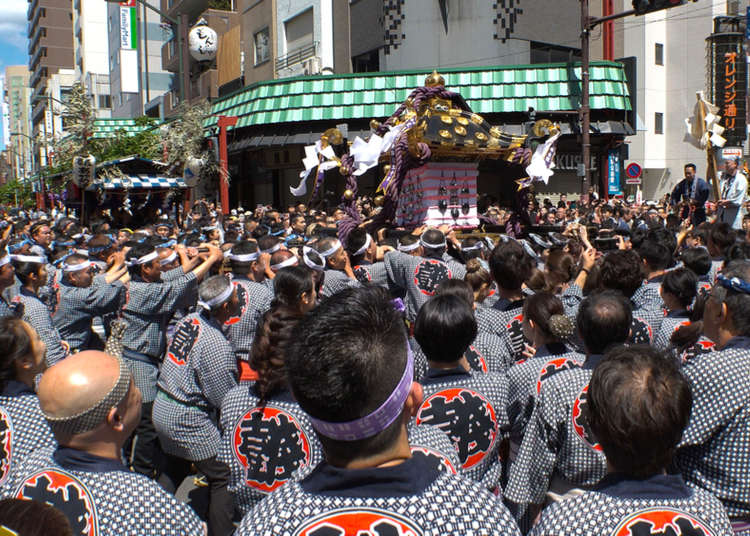
The Sanja Matsuri is one of Tokyo’s best traditional festivals during the summer, with around two million spectators attending over the 3-day period including Tokyo locals, Japanese tourists and international tourists from around the globe.
Over the course of three days, mikoshi, or portable shrines, are paraded around the famous area of Asakusa, on Tokyo’s eastern side. Alongside these parades are musicians, dancers and other performers in traditional clothes, while stalls appear as if by magic offering up all kinds of delicacies. Anyone who is in Tokyo during May absolutely has to join in and have fun!
- Table of Contents
-
- Origins of the Sanja Matsuri
- When is Sanja Matsuri 2022?
- Present-day celebration
- Outline of the Sanja Matsuri
- What do locals wear during the matsuri?
- Carrying the mikoshi
- How do people join the Sanja Matsuri?
- How to Prepare For the Sanja Matsuri
- Brief Word on Japanese Festival Etiquette
- Getting to and from the Sanja Matsuri
Origins of the Sanja Matsuri
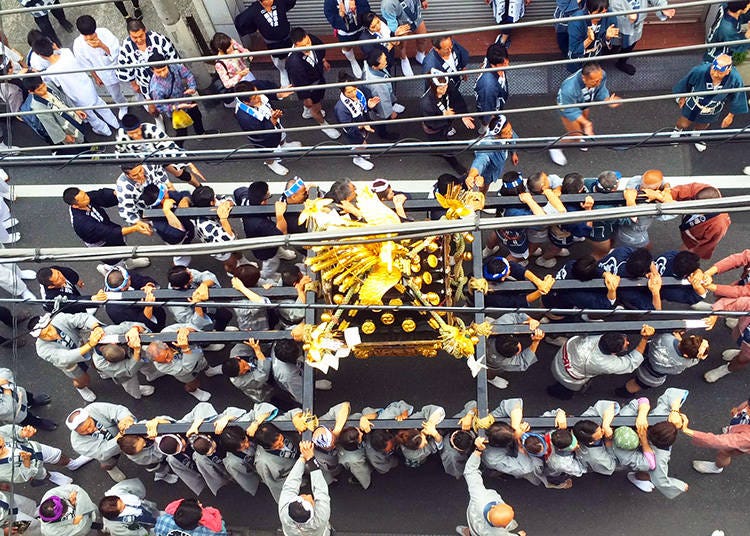
Every year huge numbers of people attend the Sanja Matsuri, one of the three great Shinto festivals in Tokyo. This festival is an absolutely marvelous opportunity to experience not just Japanese culture, but a real local community spirit. Its distant origins can be found in 1649 when the shogun Tokugawa Iemitsu ordered the construction of Asakusa Shrine, which was dedicated to two brothers - Takenari and Hamanari Hinokuma – and their friend, Matsuchi Hajino, for their role in establishing Sensoji Temple in 628.
The three men became known as “Sanja-sama,” and the festival became known as Sanja Matsuri in their honor. It is also believed that a festival was held from 1312 in honor of the Sanja-sama, but this only took place every other year in March until 1649. So, today when you see the Sanja Matsuri you are in fact witnessing a powerful cultural tradition that has taken place over the best part of a thousand years being celebrated by the Ujiko (inhabitants of the neighboring community). In 1951 the Asakusa Shrine was designated as an Important National Cultural Asset.
When is Sanja Matsuri 2022?
Sanja Matsuri will be held from May 20-22, 2022.
Present-day celebration

Today it takes place every year over the course of the third weekend of May, starting at 1pm on Friday and ending on Sunday evening.
Over the course of the three days this annual festival includes a procession with people dressed in Edo Period attire and dancers performing a special dance on the first day, a procession of 100 portable shrines (mikoshi) on the second day and then a procession of three large portable shrines on the last day. The mikoshi are blessed at Sensoji Temple and Asakusa Shrine, and then carried through the 44 districts of Asakusa in order to spread luck and fortune to the local people and businesses.
For some people, or maybe many people, one of the highlights of the Sanja Matsuri is the amazing food which is available to buy at stalls on many of the streets, this includes typical Japanese dishes such as yakisoba, yakitori, and more. However, more importantly you can try unique local delicacies like Asakusa Kibi-dango Azuma, said to date back over two hundred years and which is made from millet powder (kibi) and sweet rice, and coated with soybean flour. Asakusa is also famous for Age Monjya, which is like a light pastry with filling of your choice. A favorite for a hot day is Matcha Kakigori, shaved ice topped with matcha syrup on top of red beans!
Outline of the Sanja Matsuri
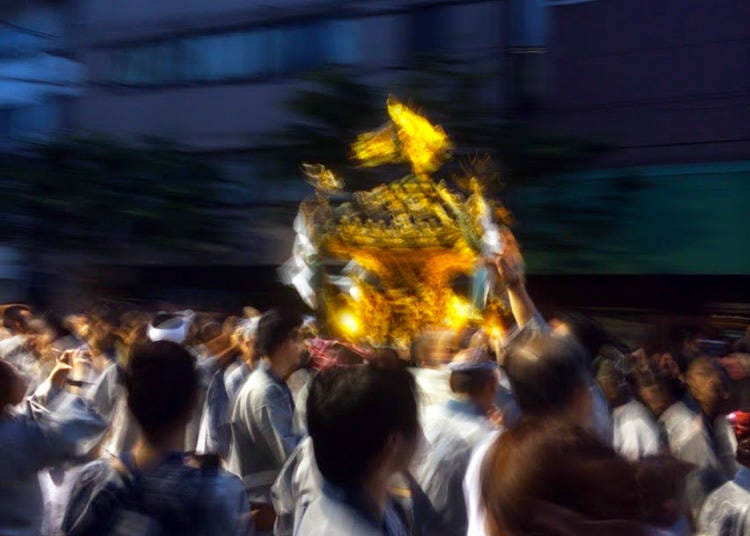
Friday
The night before the first day the head priest of Asakusa Shrine performs a ritual to invite the spirits of the Sanja-sama into the three main mikoshi, and then on Friday the matsuri kicks off with the Daigyoretsu Parade at 1 p.m. This parade is made up of temple priests, city officials, geishas, musicians and dancers wearing traditional costumes who walk through the various areas of Asakusa.
This is followed by a brief Shinto ceremony at Asakusa Shrine to pray for prosperity and dancers performing the binzasaramai dance, a performance accompanied by traditional Japanese percussion instruments known as binzasara.
In the late afternoon six giant mikoshi from the main districts are paraded through the streets. It is a great chance to get up and close to the mikoshi ahead of the very crowded weekend. At the same time all of the local people eat and drink in the streets, while children play games.
Saturday
On Saturday, the second day of the matsuri, the festivities really kick off, at around noon around 100 small mikoshi are carried through the streets across Asakusa. Each mikoshi is carried by a different team of around 60 people who shout in unison to cheer each other one while the streets heave with all of the spectators.
The many mikoshi being carried through the streets also include smaller ones which are for children of different ages. To let even toddlers enjoy the festivities, there is a taiko drum that’s mounted in a cart which they’ll play while being wheeled around the neighborhood. It is really a day for everyone!
As a spectator, you might be expecting these mikoshi, as shrines, to be treated very respectfully, so you will be surprised when you see the mikoshi actually being bounced up and down, and also thrown from side to side! This movement of the mikoshi is known as tamafuri, and has been done for hundreds of years because if it is done at a festival then the local people will be lucky in terms of great harvests, of both crops and fish, as well as helping illnesses get better.
As the day comes to an end the various teams and their mikoshi crowd into Asakusa Shrine until you have a sea of mikoshi and colors vying together to grab your attention. Later the teams, local people and other visitors get together for drinks across the whole of Asakusa, and usually drink until the early hours.
Sunday
The final day of the festival begins very early at 6am at Asakusa Shrine, all of the teams from the previous day (sometimes a little worse to wear from the previous night) jostle each other to get to the three big mikoshi and be the ones to carry one of them.
These mikoshi are truly big and weigh at least a ton, and as the teams are very competitive spectators are not allowed in the shrine area for their own safety.
By around 8 a.m. the three big mikoshi depart the shrine and travel on separate routes around Asakusa until returning back to the shrine around 6 or 7 p.m. After the big mikoshi leave in the morning the remaining teams will also parade some of the smaller mikoshi from the previous day as well.
What do locals wear during the matsuri?
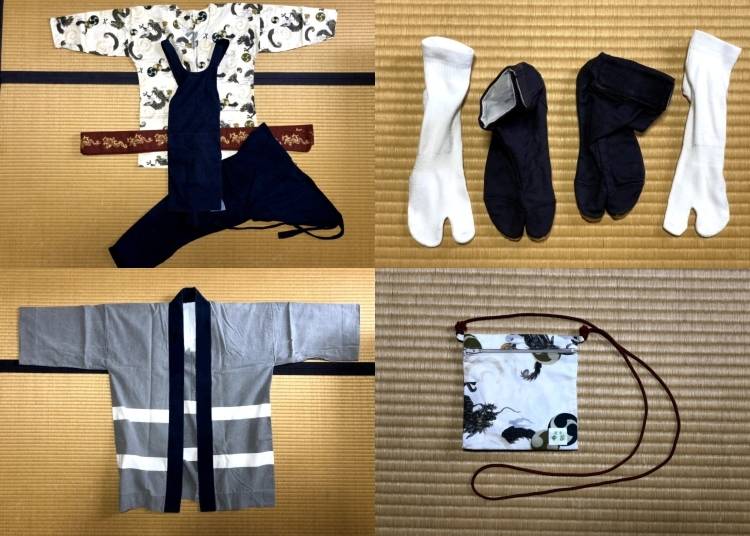
Each mikoshi team wears a different hanten coat, which is like a traditional short coat. This hanten is thicker than a normal one, which is understandable as otherwise there would be a lot of friction with carrying the mikoshi. People may compete to carry a mikoshi, but they don’t want to get an injury! Underneath they normally wear fundoshi, a traditional Japanese undergarment which adds further support and comfort. The outfit is completed with traditional tabi, a kind of boot that might put you in mind of ninjas, and finally a hachimaki (handband).
Carrying the mikoshi
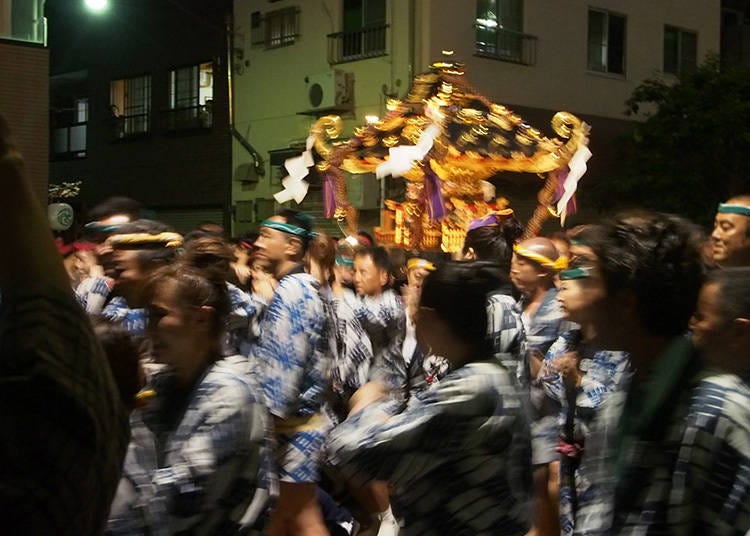
Mikoshi range in size from the small children’s one to the heavy main ones of the sanja-sama. As an adult, if you participate, you can expect to be carrying one that, although doesn’t appear to be that big, still weighs hundreds of pounds. Whereas the truly big ones can weigh up to 1200 pounds.
The teams who carry the mikoshi all lift it with their shoulders, and hold on to the wooden poles with both hands in front of them.
As the mikoshi moves forward everyone shouts wasshoi! wasshoi! to help encourage each other, while team leaders shout and blow whistles to spur on the team.
Being part of a mikoshi team isn’t just a matter of exercise, or strength and stamina; it is about accomplishing a hard task together which one person alone can’t do. Without the team working together it would be impossible to carry the heavy load anywhere, and it is also about being strong and carrying the weight of the community together.
How do people join the Sanja Matsuri?
Participants are from neighborhoods and, generally, visitors would not carry the mikoshi. Occasionally, in some neighborhoods, foreign visitors on the sidelines might be invited to try their hand at carrying the mikoshi. Declining isn’t considered rude – just do as you feel comfortable and follow others’ lead.
How to Prepare For the Sanja Matsuri
1. Expect huge crowds. This can’t be stressed enough: As one of Tokyo’s most popular festivals, you will see a constant stream of people coming into and leaving the Asakusa area.
2. Expect lines for toilets. Although public toilets are able to be found in the area, there may be something of a line. A fair alternative can be walking a block or two away from the center of the action and asking at a convenience store to use theirs.
3. Plan for rain. While not the case every year, more often than not, there is a day of wetter weather. Bring rain gear and a portable umbrella just in case.
4. But also prepare for sun. If it’s not raining, the sun can be surprisingly strong at this time of year. After checking the weather report, bring along some sunscreen and a hat.
5. Be aware of your surroundings. The areas closest to the mikoshi routes will be quite crowded. While Japan is relatively safe from pickpockets, be smart about your belongings. Also, be aware of where the mikoshi – and the teams of people – are heading. Mind that many might be slightly tipsy and the crowds might change direction suddenly – be sure not to get squashed!
6. Leave room in your tummy! There will be festival food galore, particularly in the area immediately around Sensoji Temple. Be sure to enjoy snacking on the many delights offered! It’s a fantastic time not only to enjoy a major Japanese festival, but some of its truly amazing food culture as well.
Brief Word on Japanese Festival Etiquette
Despite its festive appearance, the mikoshi is holy and should be respected accordingly - don’t touch or sit on it. Photographs are generally fine, but try to avoid flash photography when taking pictures of people carrying the mikoshi so as not to blind or disorient them. (Remember, mikoshi are incredibly heavy!)
Getting to and from the Sanja Matsuri
The closest station is Asakusa Station on both the Ginza and Asakusa lines, however, these will also be absolutely jam-packed during the festival. Where possible consider other stations which are within walking distance like Asakusa Station (on the Tsukuba Express line), Honjo-Azumabashi Station (on the Toei Asakusa Line), Kuramae Station (on the Toei Asakusa Line) or Tawaramachi Station (on the Tokyo Metro Ginza line).
-

-
Address
2-3-1, Asakusa, Taitou-ku, Tokyo, 111-0032
View Map -
Nearest Station
Asakusa Station (Tokyo Metro Ginza Line / Toei Asakusa Line / Tobu Isesaki Line (Tobu Skytree Line) / Tsukuba Express)
7 minutes on foot
- Phone Number 03-3844-1575
-
Address
2-3-1, Asakusa, Taitou-ku, Tokyo, 111-0032
-

-
Address
2-3-1, Asakusa, Taitou-ku, Tokyo, 111-0032
View Map -
Nearest Station
Asakusa Station (Tokyo Metro Ginza Line / Toei Asakusa Line / Tobu Isesaki Line (Tobu Skytree Line) / Tsukuba Express)
5 minutes on foot
- Phone Number 03-3842-0181
-
Address
2-3-1, Asakusa, Taitou-ku, Tokyo, 111-0032
*Prices and options mentioned are subject to change.
*Unless stated otherwise, all prices include tax.
Popular Tours & Activitiess
Recommended places for you
-

Jujutsu Kaisen Takes Over JR East With a Wrapped Shinkansen This Winter
by: Guest Contributor
-
Ad

Discover the "Miraculous Forest" in the Heart of Tokyo: The Institute for Nature Study (9 Minutes from JR Meguro Station)
-
Ad

Preserving the Beauty of World Heritage Site Shirakawa-go for the Future Through Responsible Travel
-

This Winter, Godzilla Takes Over Haneda Airport
by: Guest Contributor
-

How to Get Don Quijote's Exclusive 2025-2026 Winter Gift (+Tax-Free Savings)
-

Strawberries, Style, and Tokyo’s Coolest Neighborhood: Winter Afternoon Tea in Kichijoji
by: Guest Contributor
Inspiration for Accommodations
-

Enjoy Mt. Fuji from the Comfort of Your Room! Recommended Ryokan with Mt. Fuji View
-

Stay Near the Cherry Blossoms! Hotels for Cherry Blossom Viewing in Tokyo
-

Family-Friendly Hotels with Free Shuttle to Disneyland: Convenient Access for a Magical Stay
-

Top Ranked Hakone Hotels with Mt. Fuji View: Enjoy Stunning Scenery from Your Private Space
-

Convenient Tokyo Hotels with Airport Shuttle: Ideal for Families and Heavy Luggage
-

Stunning Tokyo Tower View Hotels: Enjoy Spectacular Scenery from Your Private Space
-

Convenient Asakusa Hotels with Kitchens: Ideal for Extended Family Visits
-

Experience Luxury: Hakone's 10 Best Five-Star Accommodations
-

Enjoy Mt. Fuji Autumn Leaves! Top Hotels Near the Popular Autumn Leaves Corridor
-

Experience Hakone Fall Foliage from Your Room with Stunning Views
-

4 Best Tokyo Festivals in March: Fun Ways to Greet Spring
-

Asakusa Sanja Matsuri (May 16-18, 2025): Inside One of Tokyo's Greatest Festivals
by: Jiei Kurabayashi
-

Ikebukuro Station Area Guide: Top 15 Spots When You Escape the Station's Maze!
-

Tokyo Roppongi: 5 Most Amazing Spots at Roppongi Hills and How to Make the Best of Them!
-

Awa Odori Comes to Shibuya June 21: Experience the Soul of Tokushima in the Heart of Tokyo
-

The Best of Japan: 11 Major Cities Every Traveler Should Visit
- #best ramen tokyo
- #what to buy in ameyoko
- #what to bring to japan
- #new years in tokyo
- #best izakaya shinjuku
- #things to do tokyo
- #japanese nail trends
- #what to do in odaiba
- #onsen tattoo friendly tokyo
- #daiso
- #best sushi ginza
- #japanese convenience store snacks
- #best yakiniku shibuya
- #japanese fashion culture
- #best japanese soft drinks




















